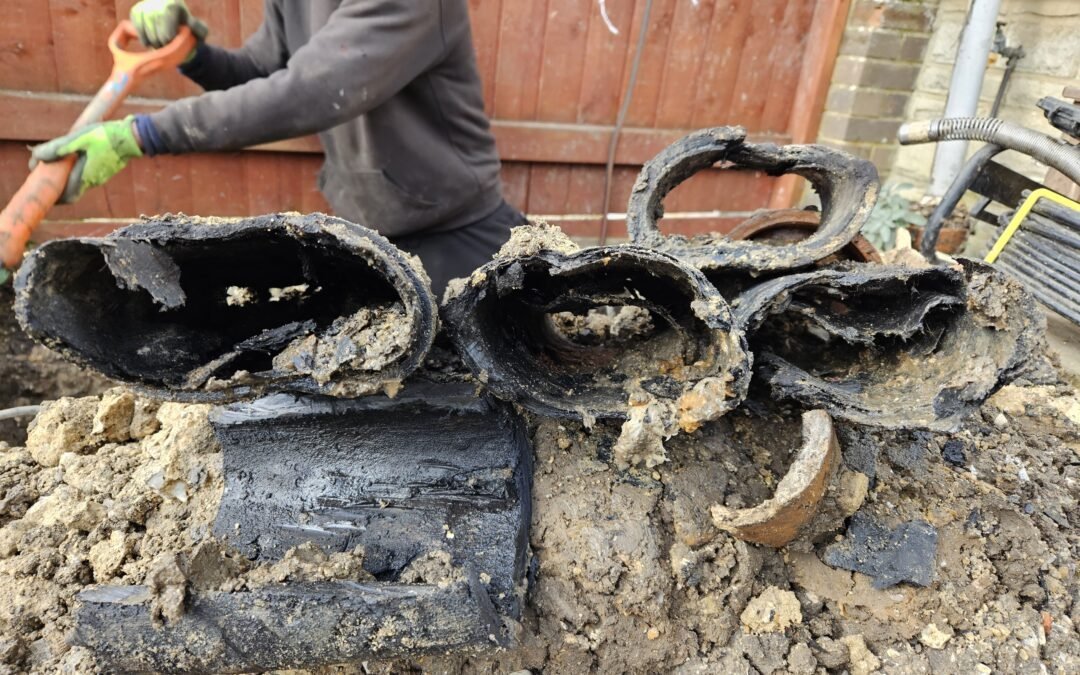Understanding Pitch Fibre Drains and Their Challenges
Pitch fibre drains were a popular choice for domestic and commercial drainage systems in the mid-20th century due to their lightweight and cost-effective nature. However, despite their early appeal, they have become a significant concern for property owners due to their tendency to deteriorate over time.
In this blog, we’ll explore what pitch fibre drains are, the most common issues they face, and what can be done to repair or replace them.
What Are Pitch Fibre Drains?
Pitch fibre pipes were manufactured using wood cellulose impregnated with coal tar or bitumen to create lightweight yet durable drainage systems. These pipes were widely installed in properties between the 1950s and 1970s, especially in the UK, where post-war construction demanded affordable materials.
While they offered initial cost savings, the drawbacks of pitch fibre drains became apparent over time. These pipes were prone to deformation, collapsing, and other structural issues, requiring modern solutions to keep drainage systems functioning effectively.
Why Do Pitch Fibre Drains Fail?
The main issue with pitch fibre pipes is their vulnerability to structural degradation. Over the years, they can soften due to prolonged exposure to heat, water, and pressure from surrounding soil. Some of the most common causes of pitch fibre drain failure include:
- Delamination: Over time, pitch fibre pipes delaminate, where the layers separate and weaken the pipe’s structure. This leads to blockages and creates an environment where debris easily accumulates. Left unchecked, delamination can cause complete structural failure.
- Blistering and Bulging: Blisters often form in the inner layers of the pipe, causing irregularities and restrictions in flow.
- Deformation: The lightweight material can flatten or collapse under pressure from heavy loads or ground movement.
Addressing these issues often requires professional services such as drain repairs or complete pipe replacements.
The Impact of Delamination on Pitch Fibre Drains
Delamination is one of the most severe problems affecting pitch fibre pipework. This phenomenon occurs when the bonded layers of the pipe material start to peel away, leading to compromised structural integrity.
As delamination progresses, the pipe loses its ability to maintain its shape, and sections may collapse entirely. This results in frequent blockages, water leakage, and increased risk of tree root intrusion. Additionally, delaminated sections of the pipe often trap sediment and other debris, accelerating the degradation process.
Property owners facing this issue should act quickly by contacting professionals to assess the extent of damage. A CCTV drain survey is often the best starting point to evaluate the condition of pitch fibre pipes.
Repairing or Replacing Pitch Fibre Drains
If you suspect issues with your pitch fibre drains, there are effective solutions available to restore functionality:
- Drain Relining: For minor damage, such as small cracks, drain relining can be used to reinforce the pipe without excavation. This involves inserting a resin-soaked liner that hardens into a durable inner coating.
- Pipe Replacement: When delamination or deformation is extensive, replacing the entire pipe may be necessary. This ensures long-term reliability.
- CCTV Drain Surveys: Identifying the root cause of drainage problems begins with a comprehensive CCTV drain survey. This process helps locate the exact area of damage and guides repair strategies.
At Rapid Drains, we offer a range of services to tackle pitch fibre pipework, from blocked drain clearance to complete drain repairs.
Preventing Future Drainage Problems
Maintaining the health of your drains can help prevent issues from arising. Here are some tips to avoid costly repairs:
- Regular Inspections: Schedule periodic drain checks to catch problems early.
- Avoid Harsh Chemicals: While tempting, chemical drain cleaners can exacerbate pipe damage.
- Monitor Tree Roots: Roots can infiltrate old and weakened pipes, causing significant damage over time.
We also recommend exploring our CCTV drain surveys for early identification of potential problems.
Benefits of Modern Drainage Solutions
By upgrading old pitch fibre pipes with modern materials like PVC or HDPE, property owners can enjoy a range of benefits, including:
- Enhanced durability
- Improved flow rates
- Lower maintenance requirements
Our team at Rapid Drains specializes in replacing outdated pitch fibre pipe systems with modern solutions.
Related Resources
For further guidance on drainage maintenance and repairs, check out our other blog posts:
- The Importance of Regular Drain Cleaning
- How to Prevent Blocked Drains in Your Home
- Drain Relining Explained
For additional technical insights on pitch fibre drains, refer to Water UK, a reputable resource for all things related to water and drainage infrastructure.

